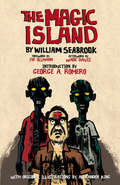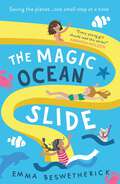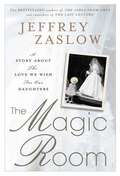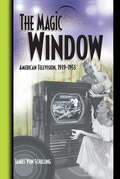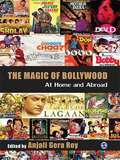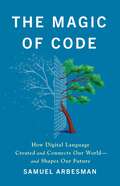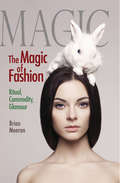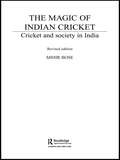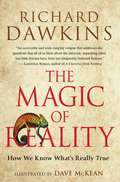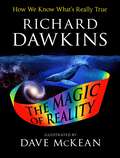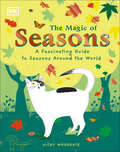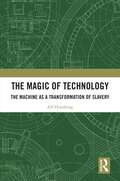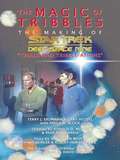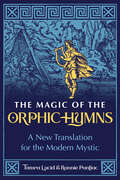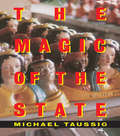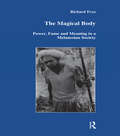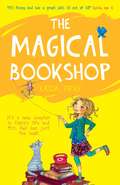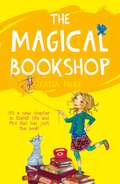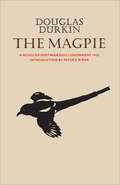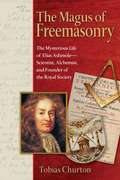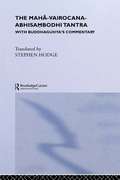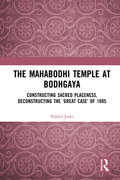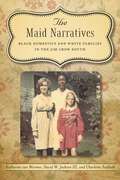- Table View
- List View
The Magic Island
by William Seabrook George A. Romero Joe Ollmann Alexander King"The best and most thrilling book of exploration that we have ever read ... [an] immensely important book." -- New York Evening Post"A series of excellent stories about one of the most interesting corners of the American world, told by a keen and sensitive person who knows how to write." -- American Journal of Sociology"It can be said of many travelers that they have traveled widely. Of Mr. Seabrook a much finer thing may be said -- he has traveled deeply." -- The New York Times Book ReviewThis fascinating book, first published in 1929, offers firsthand accounts of Haitian voodoo and witchcraft rituals. Journalist and adventurer William Seabrook introduced the concept of the walking dead - zombies - to the West with his illustrated travelogue. He relates his experiences with the voodoo priestess who initiated him into the religion's rituals, from soul transference to resurrection. In addition to twenty evocative line drawings by Alexander King, this edition features a new Foreword by cartoonist and graphic novelist Joe Ollmann, a new Introduction by George A. Romero, legendary director of Night of the Living Dead, and a new Afterword by Wade Davis, Explorer in Residence at the National Geographic Society.
The Magic Ocean Slide: Playdate Adventures (The Playdate Adventures)
by Emma Beswetherick&“Guaranteed free of unicorns and princesses, it&’s fun, empowering fiction for 5-8 year olds.&” David Nicholls, author of One Day &“Every young girl should read this series!&” Amanda Holden &“I loved learning about how the ocean is in trouble.&” Tess, age 6 Join best friends Katy, Cassie and Zia on a series of amazing adventures as they work together to save the planet… On the hottest day of the year, the friends imagine a water slide coming out of Katy&’s bedroom window. As they plunge into an underwater world, they can&’t wait to explore. But when they meet a dolphin in distress, they realise the ocean is in big trouble. It&’s so full of plastic that the sea creatures have been forced to flee their homes. Can the friends come up with a plan to put things right?
The Magic Ocean Slide: Playdate Adventures (The Playdate Adventures)
by Emma Beswetherick&“Guaranteed free of unicorns and princesses, it&’s fun, empowering fiction for 5-8 year olds.&” David Nicholls, author of One Day &“Every young girl should read this series!&” Amanda Holden &“I loved learning about how the ocean is in trouble.&” Tess, age 6 Join best friends Katy, Cassie and Zia on a series of amazing adventures as they work together to save the planet… On the hottest day of the year, the friends imagine a water slide coming out of Katy&’s bedroom window. As they plunge into an underwater world, they can&’t wait to explore. But when they meet a dolphin in distress, they realise the ocean is in big trouble. It&’s so full of plastic that the sea creatures have been forced to flee their homes. Can the friends come up with a plan to put things right?
The Magic Room
by Jeffrey ZaslowThe New York Times bestselling author of The Girls from Ames shares an intimate look at a small-town bridal shop, its multigenerational female owners, and the love between parents and daughters as they prepare for their wedding day. Thousands of women have stepped inside Becker’s Bridal, in Fowler, Michigan, to try on their dream dresses in the Magic Room, a special space with soft lighting, a circular pedestal, and mirrors that carry a bride’s image into infinity. The women bring with them their most precious expectations about romance, love, fidelity, permanence, and tradition. Each bride who passes through has a story to tell—one that carried her there, to that dress, that room, that moment. Illuminating the poignant aspects of a woman’s journey to the altar, The Magic Room tells the stories of memorable women on the brink of commitment. Run by the same family for four generations, Becker’s has witnessed transformations in how America views the institution of marriage: some of the shop’s clientele are becoming stepmothers, some are older brides, some are pregnant. Shop owner Shelley has a special affection for all the brides, hoping their journeys will be easier than hers. Jeffrey Zaslow weaves their true stories using a reporter’s research and a father’s heart. The lessons Zaslow shares from within the Magic Room are at times joyful, at times heartbreaking, and always with insight on marriage, family, and the lessons that parents—especially mothers—pass on to their daughters about love. Weaving together secrets, memories, and family tales, The Magic Room explores the emotional lives of women in the twenty-first century. .
The Magic Window: American Television ,1939-1953
by Jim Von SchillingFirst published in 2002. Routledge is an imprint of Taylor & Francis, an informa company.
The Magic of Bollywood
by Anjali Gera RoyFew would deny that the most significant weapon in India's cultural and artistic armory is its avowedly commercial cinema, now known as Bollywood. This anthology aims to portray the "soft" power of Bollywood, which makes it a unique and powerful disseminator of Indian culture and values abroad. The essays in the book examine Bollywood's popularity within and outside South Asia, focusing on its role in international relations and diplomacy. In addition to contributions that directly engage with the notion of soft power, a number of essays in the volume testify to the attractiveness of Bollywood cinema for ethnically diverse groups across the world, probe the reasons for its appeal, and explore its audiences' identification with cinematic narratives. Established and emerging scholars in literature, theater, film, dance, music, media, cultural studies, and sociology from different parts of the world present their views from multidisciplinary perspectives based on case studies from Australia, New Zealand, the UK, Germany, Russia, the US, Senegal, Pakistan, Bangladesh, Indonesia and Canada, in addition to India.
The Magic of Code: How Digital Language Created and Connects Our World—and Shapes Our Future
by Samuel ArbesmanIn the tradition of classics such as The Lives of a Cell, a bold reframing of our relationship with technology that argues code is "a universal force—swirling through disciplines, absorbing ideas, and connecting worlds" (Linda Liukas). In the digital world, code is the essential primary building block, the equivalent of the cell or DNA in the biological sphere—and almost as mysterious. Code can create entire worlds, real and virtual; it allows us to connect instantly to people and places around the globe; and it performs tasks that were once only possible in science fiction. It is a superpower, and not just in a technical sense. It is also a gateway to ideas. As vividly illustrated by Samuel Arbesman, it is the ultimate connector, providing new insight and meaning into how everything from language and mythology to biblical texts, biology, and even our patterns of thought connect with the history and nature of computing. While the building block of code can be used for many wondrous things it can also create deeper wedges in our society and be weaponized to cause damage to our planet or our civilization. Code and computing are too important to be left to the tech community; it is essential that each of us engage with it. And we fail to understand it to our detriment. By providing us with a framework to think about coding and its effects upon the world and placing the past, current, and future developments in computing into its broader setting we see how software and computers can work for people as opposed to against our needs. With this deeper understanding into the &“why&” of coding we can be masters of technology rather than its subjects.
The Magic of Fashion: Ritual, Commodity, Glamour (Anthropology and Business)
by Brian MoeranDrawing on 20 years of ethnographic fieldwork and anthropological theory, anthropologist Brian Moeran argues that fashion magazines are able to cast a spell over their readers by using practices and rituals found in age-old magical and religious rites.
The Magic of Indian Cricket: Cricket and Society in India (Sport in the Global Society)
by Mihir BoseIn the last twenty years, Indian cricket has been transformed. With the arrival of global television networks, mass-media coverage and multinational sponsors, cricket has become big business and India has become the economic driving force in the world game. For the first time a developing country has become a major player in the international sports arena. This fully updated and revised edition of Mihir Bose's classic history is a unique account of the Indian cricket phenomenon. Drawing on a combination of extensive research and personal experience, Bose traces the development of the Indian game from its beginnings as a colonial pastime to its coming of age as a national passion and now a global commercial powerhouse. This illuminating study reveals Indian cricket's central place in modern India’s identity, culture and society. Insightful, honest and challenging, Bose tackles the myths and controversies of Indian cricket. He considers the game in terms of race, caste, politics, national consciousness and ambition, money, celebrity and the media, evoking all the unpredictability, frustration and glory that is the magic of Indian cricket.
The Magic of Reality: How We Know What's Really True
by Richard DawkinsAn elegant, text-only edition of the New York Times bestseller that&’s been hailed as the definitive authority on…everything.Richard Dawkins, bestselling author and the world&’s most celebrated evolutionary biologist, has spent his career elucidating the many wonders of science. Here, he takes a broader approach and uses his unrivaled explanatory powers to illuminate the ways in which the world really works. Filled with clever thought experiments and jaw-dropping facts, The Magic of Reality explains a stunningly wide range of natural phenomena: How old is the universe? Why do the continents look like disconnected pieces of a jigsaw puzzle? What causes tsunamis? Why are there so many kinds of plants and animals? Who was the first man, or woman? Starting with the magical, mythical explanations for the wonders of nature, Dawkins reveals the exhilarating scientific truths behind these occurrences. This is a page-turning detective story that not only mines all the sciences for its clues but primes the reader to think like a scientist as well.
The Magic of Reality: How We Know What's Really True
by Richard DawkinsMagic takes many forms. Supernatural magic is what our ancestors used in order to explain the world before they developed the scientific method. The ancient Egyptians explained the night by suggesting the goddess Nut swallowed the sun. The Vikings believed a rainbow was the gods’ bridge to earth. The Japanese used to explain earthquakes by conjuring a gigantic catfish that carried the world on its back—earthquakes occurred each time it flipped its tail. These are magical, extraordinary tales. But there is another kind of magic, and it lies in the exhilaration of discovering the real answers to these questions. It is the magic of reality—science. Packed with clever thought experiments, dazzling illustrations and jaw-dropping facts, The Magic of Reality explains a stunningly wide range of natural phenomena. What is stuff made of? How old is the universe? Why do the continents look like disconnected pieces of a puzzle? What causes tsunamis? Why are there so many kinds of plants and animals? Who was the first man, or woman? This is a page-turning, graphic detective story that not only mines all the sciences for its clues but primes the reader to think like a scientist as well. Richard Dawkins, the world’s most famous evolutionary biologist and one of science education’s most passionate advocates, has spent his career elucidating the wonders of science for adult readers. But now, in a dramatic departure, he has teamed up with acclaimed artist Dave McKean and used his unrivaled explanatory powers to share the magic of science with readers of all ages. This is a treasure trove for anyone who has ever wondered how the world works. Dawkins and McKean have created an illustrated guide to the secrets of our world—and the universe beyond—that will entertain and inform for years to come.
The Magic of Seasons: A Fascinating Guide to Seasons Around the World (The Magic of...)
by Vicky WoodgateTake a look at the incredible changes that take place in the natural world and learn all about the seasons! From the science behind the seasons and how they affect the world around them to myths and legends and practical tips to enjoy the seasons, it's all in this incredible book for children ages 7 to 9.In Vicky Woodgate&’s follow-up title to The Magic of Sleep, children learn everything there is to know about the seasons. How do we measure a season? Why do we divide our years up and when did we start doing this? Are seasons the same for everyone? How do they work? All these questions and many more are covered in The Magic of Seasons, a practical guide to everything there is to know about the way we measure changes in weather, ecology, and daylight hours and how it affects us and the world around us. This book covers everything from what is a season and how it came to be and whether dinosaurs experienced seasons, to myths and legends, seasons at sea, and a timeline of seasons all around the world. This book is ideal for children with an interest in nature, weather, geography, and the natural world, and anyone who wants to learn all about the history and science behind what seems like such a simple part of our lives.
The Magic of Technology: The Machine as a Transformation of Slavery
by Alf HornborgThis book examines our understanding of technology and suggests that machines are counterfeit organisms that seem to replace human bodies but are ultimately means of displacing workloads and environmental loads beyond our horizon. It emphasizes that technology is not the politically neutral revelation of natural principles that we tend to think, but largely a means of accumulating, through physically asymmetric exchange, means of harnessing natural forces to reinforce social relations of power. Alf Hornborg reflects on how our cultural illusions about technology appeared in history and how they continue to stand in the way of visions for an equal and sustainable world. He argues for a critical reconceptualization of modern technology as an institution for redistributing human time, resources, and risks in world society. The book highlights a need to think of world trade in other terms than money and raises fundamental questions about the role of human-artifact relations in organizing human societies. It will be of interest to a range of scholars working in anthropology, sociology, economics, development studies, and the philosophy of technology.
The Magic of Tribbles
by Terry J. Erdmann Paula M. Block Gary HutzelWhen the writers of Star Trek: Deep Space Nine were looking for the perfect episode with which their characters could pay homage and interact with the crew from the original Star Trek , "The Trouble with Tribbles" instantly came to mind. Here is the story of how the wizards of Star Trek were able to create the magic that enabled- with nothing more than countless hours of work- ordinary actors to time-travel. This is the story behind the creation of the episode "Trials and Tribble-ations." This is The Magic of Tribbles.
The Magic of the Orphic Hymns: A New Translation for the Modern Mystic
by Tamra Lucid Ronnie PontiacRecaptures the magical vitality of the original Orphic Hymns• Presents literary translations of the teletai that restore important esoteric details and correspondences about the being or deity to which each hymn is addressed• Includes messages inscribed on golden leaves meant to be passports for the dead as well as a reinvention of a lost hymn to Number that preserves the original mystical intent of the teletai• Explores the obscure origins and the evolution of the Orpheus myth, revealing a profound influence on countercultures throughout Western historyAs famous Renaissance philosopher Marsilio Ficino wrote, &“No magic is more powerful than that of the Orphic Hymns.&” These legendary teletai of Orpheus were not simply &“hymns&”—they were initiatic poems for meditation and ritual, magical, and ceremonial use, each one addressed to a specific deity, such as Athena or Zeus, or a virtue, such as Love, Justice, and Equality. Yet despite the mystical concepts underlying them, the original hymns were formulaic, creating an obstacle for translators. Recapturing the magical vitality that inspired mystery cults through the ages, Tamra Lucid and Ronnie Pontiac present new versions of the teletai that include important esoteric details and correspondences about the being or deity to which each hymn is addressed. The authors also include a new version of a lost hymn called &“Number&” and messages that were inscribed on golden leaves meant to be passports for the dead, reinventions that preserve the original magical intent and mysticism of the teletai. Revealing the power of the individual hymns to attune the reader to the sacred presence of the Orphic Mysteries and the higher order of nature, the authors also show how, taken together, the Orphic Hymns are a book of hours or a calendar of life, addressing every event, from birth to death, and walking us through all the experiences of human existence as necessary and holy.
The Magic of the State
by Michael TaussigSet in the enchanted mountain of a spirit-queen presiding over an unnamed, postcolonial country, this ethnographic work of ficto-criticism recreates in written form the shrines by which the dead--notably the fetishized forms of Europe's Others, Indians and Blacks--generate the magical powers of the modern state.
The Magical Body: Power, Fame and Meaning in a Melanesian Society
by Richard EvesAn intriguing exploration of the role and significance of the body in the world of a Pacific Islands People, the Lelet of New Ireland (Papua New Guinea). In vivid ethnographic detail, the monograph captures the fluidity and complexity of Lelet conceptions of corporeality and their significance to identity as they encounter the influences of modernity, in the form of colonialism, Christianity and cash-cropping. The author examines the importance of the body to constructions of identity and difference, and its role in the constitution of place and space. The book provides a richly detailed ethnographic study of magical belief and the body whilst paying particular attention to the polyvalent meanings of bodily images and metaphors as they are used in numerous contexts of magic.
The Magical Bookshop
by Katja FrixeMrs Owl had a knack for finding the perfect book for every customer, before they even realised what it was they were looking for. What do you do when your best friend moves away? Clara takes comfort in her favourite place: Mrs Owl&’s bookshop. Surrounded by books that spring to life, a rhyming cat and mounds of cinnamon buns, Clara never feels alone. But someone is determined to close the bookshop down. Now it&’s up to Clara and her new friends to save it.
The Magical Bookshop
by Katja FrixeMrs Owl had a knack for finding the perfect book for every customer, before they even realised what it was they were looking for. What do you do when your best friend moves away? Clara takes comfort in her favourite place: Mrs Owl&’s bookshop. Surrounded by books that spring to life, a rhyming cat and mounds of cinnamon buns, Clara never feels alone. But someone is determined to close the bookshop down. Now it&’s up to Clara and her new friends to save it.
The Magnitude and Sources of Disagreement Among Gun Policy Experts, Second Edition
by Andrew R. Morral Terry L. Schell Rosanna SmartThis report describes combined results from two fieldings of a survey of gun policy experts. In particular, respondents estimated the likely effects of 19 gun policies on ten outcomes, such as firearm homicides and the right to bear arms. Researchers use the results to identify where experts agree and disagree the most and whether disagreements stem from assumptions about the effects of gun policies or from differences in policy objectives.
The Magpie: A Novel of Post-War Disillusionment 1923
by Douglas Durkin Peter RiderOne of the most complex experiences for Canadians was World War 1 and its attendant social upheavals. Because of the lack of a clear description of the emotional forces of the period, historians have tended to concentrate on the political manifestations of agrarian and working class unrest. There are no well-known sources for social commentary, a lack that makes this novel important as an historical document. Originally published in 1923, The Magpie is an articulate and perceptive work which provides an accurate description of the disillusionment that developed after the war when it became apparent that many of the government's promises of social reform were not going to be fulfilled. Craig Forrester – nicknamed 'The Magpie' because of his terseness in conducting business on the Winnipeg Grain Exchange – is appalled by the greed, hypocrisy, and intolerance of the 'decent' classes and opts for persona morality and social justice. Rejecting urban life, he returns to the farm of his childhood, symbol of the traditional values of honesty and simplicity. By having his hero make this choice, Durkin adopts one of the greatest themes of Canadian literature and intellectual thought – the agrarian myth. A secondary theme, of particular interest today, is the role of women in post-war society and the evolution of moral codes. The three women in 'The Magpie's' life achieve surprising degrees of personal autonomy.
The Magus of Freemasonry: The Mysterious Life of Elias Ashmole--Scientist, Alchemist, and Founder of the Royal Society
by Tobias ChurtonA comprehensive look at the life of Elias Ashmole, who represents the historic missing link between operative and symbolic Freemasonry• Explores the true role of occult and magical studies in the genesis of modern science• Explains the full meaning of the term magus, which Ashmole exemplifiedElias Ashmole (1617-1692) was the first to record a personal account of initiation into Accepted Freemasonry. His writings help solve the debate between operative and “speculative” origins of Accepted Freemasonry, demonstrating that symbolic Freemasonry existed within the Masonic trade bodies. Ashmole was one of the leading intellectual luminaries of his time: a founding member of the Royal Society, a fellowship and later academy of natural philosophers and scientists; alchemist; astrological advisor to the king; and the creator of the world’s first public museum. While Isaac Newton regarded him as an inspiration, Ashmole has been ignored by many conventional historians.Tobias Churton’s compelling portrait of Ashmole offers a perfect illustration of the true Renaissance figure--the magus. As opposed to the alienated position of his post-Cartesian successors, the magus occupied a place at the heart of Renaissance spiritual, intellectual, and scientific life. Churton shows Ashmole to be part of the ferment of the birth of modern science, a missing link between operative and symbolic Freemasonry, and a vital transmitter of esoteric thought when the laws of science were first taking hold. He was a man who moved with facility between the powers of earth and the active symbols of heaven.
The Maha-Vairocana-Abhisambodhi Tantra: With Buddhaguhya's Commentary
by Stephen HodgeThe first complete translation into English of this Tibetan text, together with the informative commentary by the 8th century master Buddhaguhya. This text is of seminal importance for the history of Buddhist Tantra, especially as very little has been published concerning the origins of Tantra in India.
The Mahabodhi Temple at Bodhgaya: Constructing Sacred Placeness, Deconstructing the ‘Great Case’ of 1895
by Nikhil JoshiThis volume investigates the historic and ethnographic accounts of the ongoing religious contestations over the status of the Mahābodhi Temple complex in Bodhgayā (a UNESCO World Heritage Site since 2002) and its surrounding landscape to critically analyse the working and construction of sacredness. It endeavours to make a ground-up assessment of ways in which human participants in the past and present respond to and interact with the Mahābodhi Temple and its surroundings.The volume argues that sacredness goes beyond scriptural texts and archaeological remains. The Mahābodhi Temple is complex and its surrounding landscape is a ‘living’ heritage, which has been produced socially and constitutes differential densities of human involvement, attachment, and experience. Its significance lies mainly in the active interaction between religious architecture within its dynamic ritual settings. This endless contestation of sacredness and its meaning should not be seen as the ‘death’ of the Mahābodhi Temple; on the contrary, it illustrates the vitality of the ongoing debate on the meaning, understanding, and use of the sacred in the Indian context. Please note: Taylor & Francis does not sell or distribute the Hardback in India, Pakistan, Nepal, Bhutan, Bangladesh and Sri Lanka
The Maid Narratives: Black Domestics and White Families in the Jim Crow South (Southern Literary Studies)
by Katherine Van Wormer David W. Jackson III Charletta SudduthThe Maid Narratives shares the memories of black domestic workers and the white families they served, uncovering the often intimate relationships between maid and mistress. Based on interviews with over fifty people -- both white and black -- these stories deliver a personal and powerful message about resilience and resistance in the face of oppression in the Jim Crow South.The housekeepers, caretakers, sharecroppers, and cooks who share their experiences in The Maid Narratives ultimately moved away during the Great Migration. Their perspectives as servants who left for better opportunities outside of the South offer an original telling of physical and psychological survival in a racially oppressive caste system: Vinella Byrd, for instance, from Pine Bluff, Arkansas, recalls how a farmer she worked for would not allow her to clean her hands in the family's wash pan. These narratives are complemented by the voices of white women, such as Flora Templeton Stuart, from New Orleans, who remembers her maid fondly but realizes that she knew little about her life. Like Stuart, many of the white narrators remain troubled by the racial norms of the time. Viewed as a whole, the book presents varied, rich, and detailed accounts, often tragic, and sometimes humorous. The Maid Narratives reveals, across racial lines, shared hardships, strong emotional ties, and inspiring strength.
